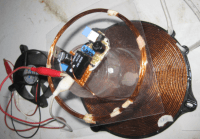Wireless Resonant Power for a 2.4GHz Security Camera

In this project, a wireless security camera is modified in order to become completely wireless (no power cord, no batteries). The power is transfered to the camera by a pair of two air-coupled coils (transmitter, receiver) and the help of resonant capacitors.
In this project, a wireless security camera is modified in order to become completely wireless (no power cord, no batteries). The power is transfered to the camera by a pair of two air-coupled coils (transmitter, receiver) and the help of resonant capacitors.
The transmitter utilizes a single power MOSFET (IRF840) in a class-E DC to AC converter configuration in order to excite the transmitter coil with a sinusoidal voltage of 50Khz frequency. The receiver consists of a resonant tank (coil, capacitor) tuned at this frequency, a rectifying diode bridge with a regulator in order to produce the proper DC voltage (12V at 130mA) required by the load and an overvoltage protective circuit.
The transmitted power can be adjusted by controling manualy the duty cycle of the pulse driving the power MOSFET of the transmitter. There is already a "prototype" (built on test board) that can transmit the needed power (1.5 W) at a distance of 13 cm. It can successfully power the wireless camera at that distance.
The receiver coil has a diameter of 10 cm and the transmitter coil is a spiral coil of 15cm diameter.
Possible improvements: Right now, the transmitter consumes about 40 W in order to transmit only 1.5W, but a lot of optimization can be made (impedance matching with load, higher frequency, optimization of transmitter power circuit) in order to make the transmission more efficient. In the "prototype" receiver, the output impedance is around 1KOhm, while the load has an impedance of 100Ohm. Matching those two, can greatly improve power transfer efficiency. On the side of the transmitter, a circuit that can measure and automatically control the transmitted power can be added (instead of manualy).
I expect the final product to be able to deliver the proper power to the camera through a wall, so that the camera can be embedded inside a frame, hanged on the wall and be powered from the back side of the wall; no power cables to the camera at all.
In the pictures attached, the "prototype" is shown to power wirelessly a 12V/130mA pc fan at a distance of 13cm.




Discussion (1 comment)
bradcit 4 years ago